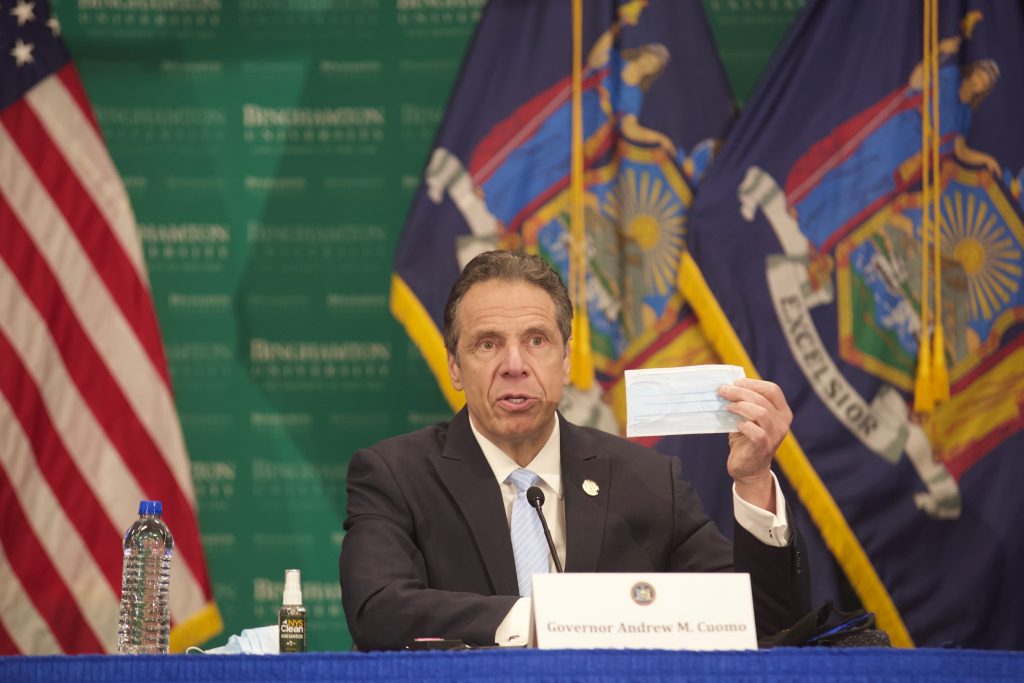A room in Binghamton University’s School of Pharmacy and Pharmaceutical Sciences was transformed with black curtains, chairs for reporters placed six feet apart from each other and a table to seat New York State (NYS) Gov. Andrew Cuomo.
On Monday, Cuomo came to BU to deliver his daily news briefing on the coronavirus pandemic. To begin, Cuomo addressed 100 cases of an inflammatory disease tied to COVID-19 that seems to affect only children.
“We thought, initially, that [COVID-19] didn’t affect children,” Cuomo said. “We’re now dealing with an issue that’s very disturbing.”
According to Cuomo, the syndrome, which is under close watch by the NYS Department of Health (DOH), has killed three children. Despite the latest reports on the new sickness, Cuomo said that overall, coronavirus cases and those affected have gone down.
Over the past two months, COVID-19 hospitalizations per day have decreased significantly, with a little over 400 reported per day now compared to the 3,000 per day in early April. These hospitalizations have mostly been contained in the New York City region and, because of that, Cuomo has given the green light for other regions in the state to open, including the Southern Tier.
In order to reopen, Cuomo said the process must occur slowly in order to track rates of hospitalizations and infections among others in each region. In order to be as transparent as possible, Cuomo said this data will be available to the general public at https://forward.ny.gov/regional-monitoring-dashboard. He added that this system is the first of its kind to be used in the nation.
“This is the most advanced way in the nation to give citizens, to give people, what they need to live their lives correctly,” Cuomo said.
Local governments will be in charge of calibrating and controlling the “reopening valve” and if COVID-19 rates start to rise, local officials can push the “circuit breaker” in order to shut their region down again. Local officials will also be in charge of enforcing businesses to follow safety protocols such as wearing masks, sanitizing regularly and honoring the six feet apart rule.
“We have our hand on the reopening valve, and we’re turning the reopening valve and we’re starting to reopen, but we’re calibrating it and we’re monitoring it,” Cuomo said.
Stemming away from New York, Cuomo called on the federal government to give states aid for the pandemic. According to the governor, New York needs $61 billion in federal support in order to continue to operate normally and if it does not receive that money, the state will need to cut funding from schools, hospitals and local governments.
In addition, the governor also unveiled his proposed “America First Law” while urging the federal government to avoid bailing out corporations. If bailed out, the governor claimed corporations would not rehire the employees they laid off. His proposed law would refuse to give money to businesses that did not rehire the same amount of employees.
Another request to the federal government was to work on public infrastructure along with the funding. Moreover, he urged states to make a bipartisan effort to aid each other during this crisis.
“Red states, blue states, they all need funding,” Cuomo said.
States across the nation are opening in direct opposition to the concerns of top health officials. Dr. Anthony Fauci, director of the National Institute of Allergy and Infectious Diseases (NIAID), noted that opening too quickly could result in an uncontrollable outbreak. In a CNN interview, Fauci said that the return of COVID-19 in the fall, or as some call it, a “second wave,” is “inevitable,” and pressed at the need for the United States to be prepared in handling it.
“We have heard people say there could be a second wave,” Cuomo said. “What does that mean? I’m not even sure.”
Cuomo noted two theories on a second wave: the possibility of a mutation and the reopening of a region too fast, resulting in a mass wave of hospitalizations. Cuomo said that although the fear is present, masks have proven to be highly effective,
“This is not a government control issue,” Cuomo said. “It doesn’t really matter what laws we put out, because government can’t enforce any of these laws. We have a regulation: You must wear a mask. How do I make 19 million people wear a mask? I can’t.”
Despite Cuomo’s admittance to not being able to enforce the rule, he made it a point to mention how the mask is a symbol of respect for others and encouraged its widespread use. According to Cuomo, rates of infection are lower in hospital workers who are frequently exposed to the virus when compared to the general public because they use recommended safety measures like masks.
“When you wear a mask you say, ‘I respect you … I respect your health, I respect your privacy, I respect your space, I respect you.’” Cuomo said. “’I can do anything I want because this is America, but I respect you.’”
Gloria Meredith, founding dean of the school of pharmacy and pharmaceutical sciences, asked the governor if he would issue an executive order for pharmacies to administer COVID-19 vaccines when available. Cuomo said he would make a decision after tracking the developments of a possible vaccine.
After the governor’s livestream audio cut off, he thanked BU President Harvey Stenger and congratulated Meredith while remarking the beauty of the new pharmacy school.



